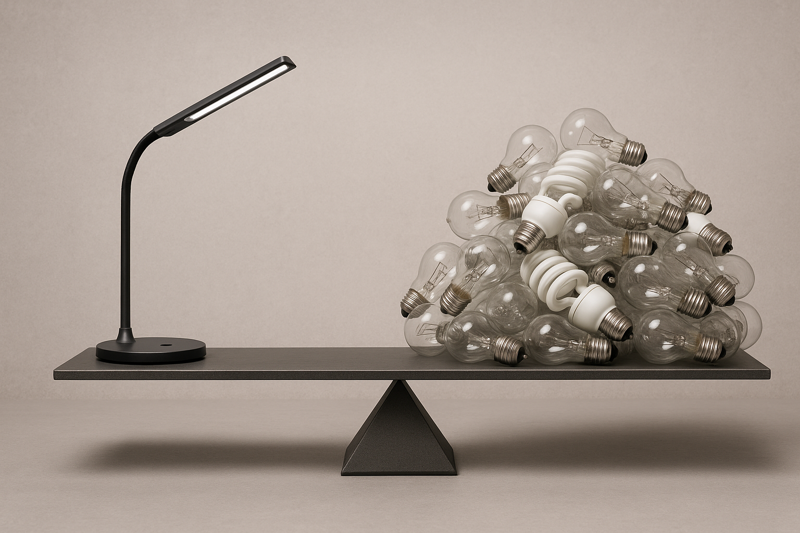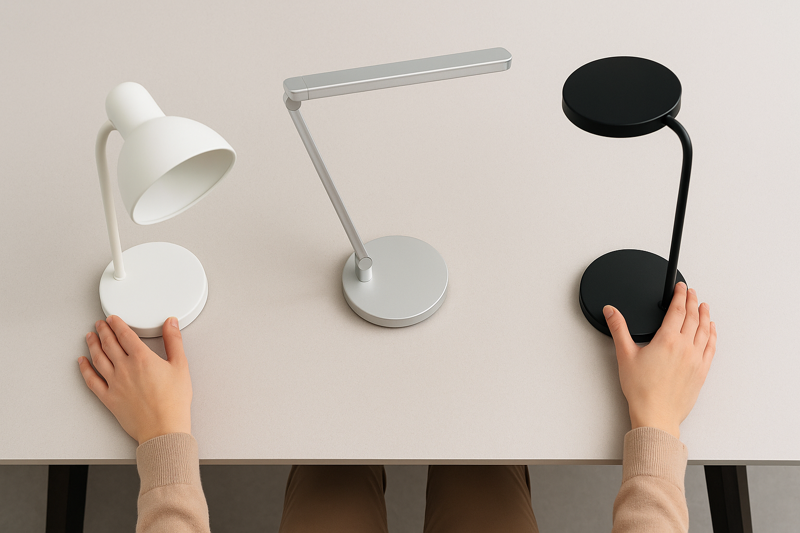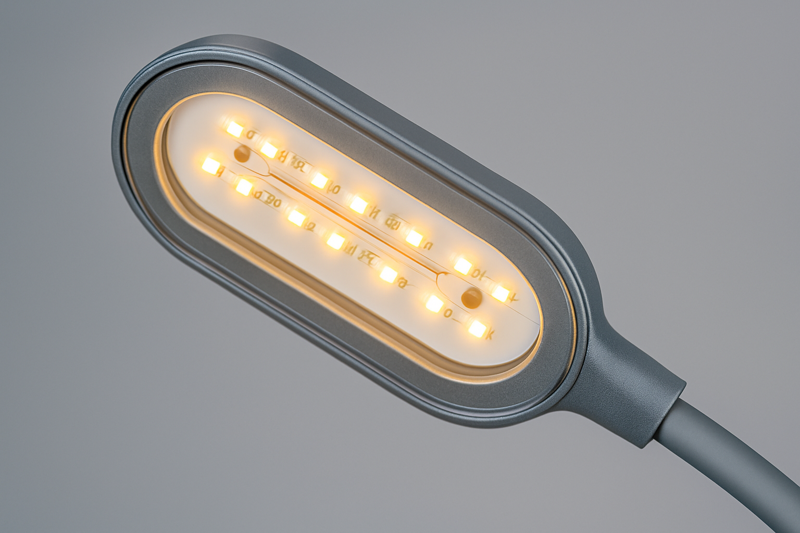
Are you baffled by how a tiny, cool-to-the-touch LED can be brighter than a big, hot glass bulb? This confusion about the technology can make it hard to appreciate the incredible value and savings LEDs offer.
LEDs are highly energy-efficient because they create light directly from electricity using a semiconductor in a process called electroluminescence, which produces very little heat, unlike old bulbs that work by heating a wire until it glows hot.
Let's explore the science behind this incredible leap in lighting technology.
How Can a Tiny Chip Make Light Without Getting Hot?
Do you remember the warning to never touch a light bulb that has been on? The intense heat from a traditional bulb is a clear sign that it is wasting an enormous amount of your electricity.
An LED is a solid-state semiconductor, not a vacuum tube with a fragile wire. It generates light when electrons move across a specially designed junction, a process that is fundamentally cool and efficient.
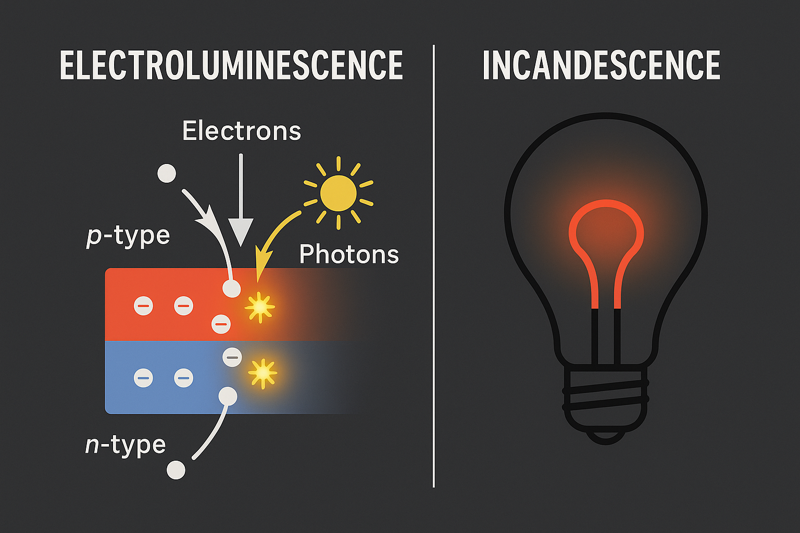
At our company, I've had the privilege of walking the factory floor with our engineers. They explained the core difference in a way I'll never forget. They said, "An incandescent bulb is a controlled fire inside a glass ball. An LED is a tiny, light-emitting computer chip." This changes everything. The old technology, called incandescence, is incredibly basic. You pass electricity through a thin, delicate wire called a filament. The wire resists the electricity, and this resistance makes it heat up. It gets so hot—thousands of degrees—that it starts to glow. The light you see is just a side effect of that extreme heat. Modern LED technology is completely different. It relies on a process called electroluminescence. An LED is a small piece of semiconductor material, similar to what's in a computer processor. It has two distinct layers, one with a surplus of electrons (the n-type) and one with a deficit of them (the p-type).
The Magic of the P-N Junction
When we apply a small amount of electricity, it pushes the electrons from the n-type layer across a boundary, called the p-n junction1, into the p-type layer. As these electrons fall into the "holes" on the other side, they release their extra energy. In these specific semiconductor materials, that energy is released in the form of a visible particle of light, a photon.
Light Without Fire
This process is a direct conversion of electricity into light at an atomic level. It does not require extreme heat to work. While some heat is produced as a byproduct, it is a tiny fraction of the heat generated by a glowing filament. This is why you can touch an LED lamp that has been on for hours without getting burned. It is a smarter, more elegant, and fundamentally more efficient way to create light.
| Technology Principle | Traditional Incandescent Bulb | Modern LED (Light Emitting Diode) |
|---|---|---|
| Name of Process | Incandescence | Electroluminescence2 |
| Core Component | A thin Tungsten Filament in a vacuum | A Solid-State Semiconductor Chip |
| How It Works | Heats a wire until it glows very hot. | Moves electrons across a junction to release photons. |
| Primary Energy Output | Heat (Approx. 90%) | Light (Approx. 50-60%) |
Where Does All the Wasted Energy in a Traditional Bulb Go?
Do you ever wonder what you are actually paying for on your electricity bill? With an old desk lamp, the shocking truth is that most of your money is being spent to heat the room, not to light it.
About 90% of the energy consumed by a traditional incandescent bulb is completely wasted as radiant heat. An LED lamp, by contrast, converts a much higher percentage of its energy directly into visible light.
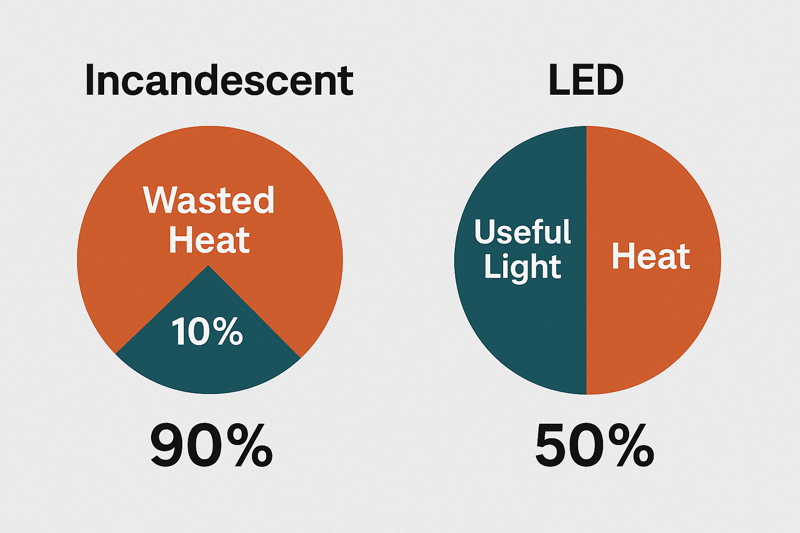
I often use a simple analogy when talking to our B2B clients who are buying thousands of lamps and are laser-focused on efficiency. I ask them, "If you had a machine that turned 90% of your raw material into useless scrap, would you keep using it?" The answer is always a firm no. Yet, for a century, that is exactly what we have all been doing with our lighting. A 60-watt incandescent bulb is more accurately described as a 54-watt heater that produces 6 watts of light as a fortunate accident. All that heat radiating from the bulb is energy that you paid for but that is not helping you see. It just warms up your office, which can even cause your air conditioning to work harder, compounding the waste. LEDs completely flip this ratio on its head.
Following the Watts
Let's think about that 60-watt number. A watt is a unit of power, or energy consumed per second. So every second, that old bulb was consuming 60 joules of electrical energy. Around 54 of those joules were converted directly into infrared radiation, which we feel as heat. Only 6 joules were converted into visible light. An equivalent 10-watt LED lamp tells a very different story. Out of the 10 joules of energy it consumes per second, around 5 joules become light and only 5 joules become heat.
The Efficiency Calculation
From this, we can see the true efficiency. The incandescent bulb is turning 6W out of 60W into light, which is a dismal 10% efficiency. The LED is turning 5W out of 10W into light, which is a massive 50% efficiency. This fivefold improvement in a device's core function is a huge technological leap.
| Energy Conversion | 60-Watt Incandescent Bulb | 10-Watt LED Lamp |
|---|---|---|
| Total Power Consumed | 60 Watts | 10 Watts |
| Power Converted to Light | Approx. 6 Watts | Approx. 5 Watts |
| Power Wasted as Heat | Approx. 54 Watts | Approx. 5 Watts |
| Luminous Efficacy | ~14 lumens per watt | ~80-100 lumens per watt |
| Energy Efficiency3 | ~10% | ~50% |
Why Doesn't an LED Waste Light by Shining It Upwards?
Have you ever noticed that a bare light bulb shines in every direction at once? For a desk lamp, any light that goes up or sideways is completely wasted, yet you are still paying for it.
LEDs are directional by nature, emitting light in a 180-degree pattern. This means all the light is directed down where you need it, unlike bulbs that waste half their light inside the lamp fixture.
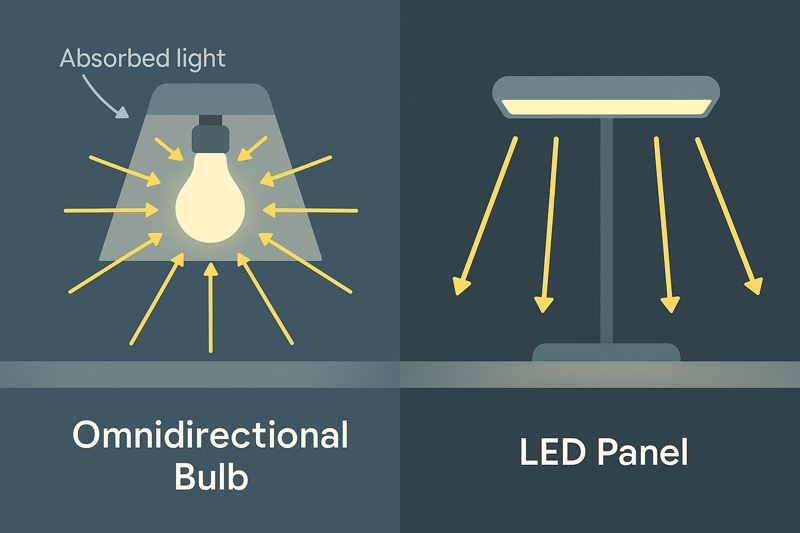
This is one of the "hidden" efficiency gains of LED technology that most people never consider, but for a task lamp, it is just as important as the electrical efficiency. When we design a lamp, our goal is to get as much useful light as possible onto the desk surface. An old-fashioned incandescent bulb is an omnidirectional source. It radiates light in a full 360-degree sphere. That means it shines light up, down, and to all sides equally. To make a desk lamp, you have to put this glowing sphere inside a shade or reflector to try and bounce all of that misdirected light back down. The problem is that every single bounce absorbs a significant amount of light. The inside of the lamp shade gets very bright, but a lot of that light never escapes; it's just converted to heat. A significant portion of the lumens you paid for are lost before they ever leave the lamp.
The Advantage of Direction
LED chips are fundamentally different. They are flat surfaces mounted on a circuit board and they emit light in a forward direction, in roughly a 180-degree arc. They do not naturally shine backwards. This means when we build an LED lamp4, we can point the chips directly at the desk. There is no need for a deep, inefficient reflector because the light is already going in the right direction. Almost every lumen we generate makes it to the work surface.
System Efficiency
This is a concept our engineers call "system efficiency5." It's not just about how efficiently the source creates light; it's about how efficiently the entire lamp system delivers that light to the target. In this measure, LEDs have a massive structural advantage that an omnidirectional bulb can never overcome. The best-designed reflector might lose 30% of the bulb's light. An LED lamp inherently loses almost none.
| Light Delivery Aspect | Traditional Bulb Lamp | Modern LED Lamp |
|---|---|---|
| Light Emission Pattern | Omnidirectional (360 degrees) | Directional (180 degrees) |
| Need for Reflectors | Absolutely necessary to redirect light. | Minimal need; light is already aimed. |
| Light Lost Inside Fixture | High (Often 30% or more) | Very Low (Almost 0%) |
| "Useful Lumens" Delivered | A fraction of the bulb's rating. | Almost all of the LED's rated lumens. |
What Is the "Brain" of an LED Lamp and How Does It Save Power?
Do you ever think about what happens between the wall outlet and the light source? For a traditional lamp, nothing does. For an LED lamp, a crucial conversion happens that directly impacts efficiency and performance.
An LED lamp uses a sophisticated electronic "driver" to convert high-voltage AC from your wall into the low-voltage DC that LEDs need. A high-quality driver performs this conversion very efficiently, minimizing wasted power.
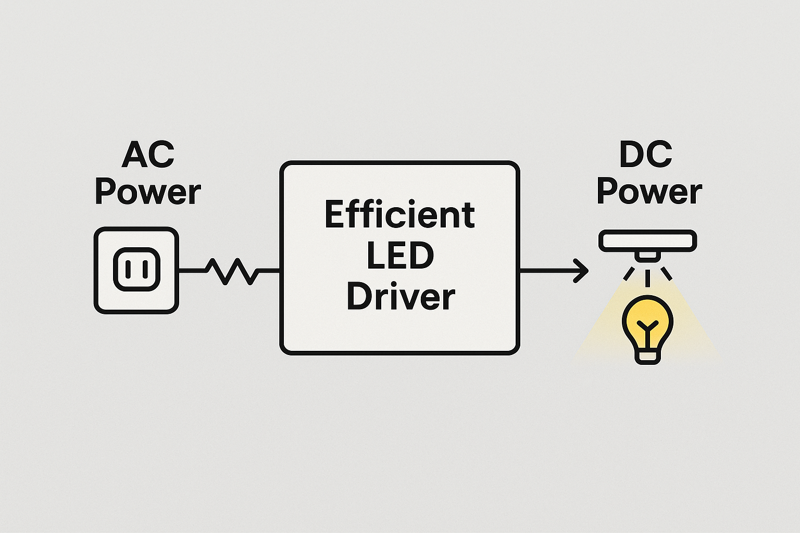
Many of our customers are surprised to learn that an LED lamp is an electronic device, not just a simple electrical one. You cannot just connect an LED chip directly to the 120-volt or 240-volt alternating current (AC) in your home. It would be destroyed instantly. LEDs are sensitive electronics that run on low-voltage, direct current (DC) power, typically somewhere between 3 and 24 volts DC. The component that manages this critical power conversion is called the driver. You can think of it as the lamp's brain or power supply. The quality of this driver is a huge factor in the lamp's overall efficiency and longevity. A cheap, poorly designed driver can be very inefficient. It might waste 20-30% of the incoming electricity as heat during the AC to DC conversion. This means that even if you have efficient LED chips, the system as a whole is wasting power. This is a common failure point in low-quality lamps.
More Than Just a Power Supply
In our high-quality lamps, we use advanced drivers6 that are more than 85% or even 90% efficient. This ensures that almost all the power pulled from the wall goes to the LEDs themselves. But the driver does much more than that. It provides a constant, stable current, which is essential for flicker-free light and helps a lot with eye comfort. It also enables all the smart features7 that modern lamps have.
Enabling Modern Features
The driver is what allows for smooth dimming, manages the different channels for changing color temperature, and controls the power going to integrated USB ports or wireless chargers. It's a complex piece of engineering. A traditional lamp has no driver. It connects the raw, high-voltage AC power directly to the bulb's filament. This is simple, but it's also crude and allows for no intelligence or advanced control. The driver is the unsung hero of modern lighting.
| Power System | Traditional Lamp | LED Lamp with High-Quality Driver |
|---|---|---|
| Input Power | High-Voltage AC (120V/240V) | High-Voltage AC (120V/240V) |
| Core Component | None (Direct Connection) | Electronic Driver |
| Output to Light Source | High-Voltage AC | Low-Voltage DC |
| Conversion Efficiency | N/A | High (>85%) |
| Enables Smart Features | No | Yes (Dimming, Color Change, USB) |
Conclusion
LEDs are more efficient through superior science: they make light directly with cool electroluminescence and direct it exactly where it's needed.
-
Understanding the p-n junction is crucial for grasping semiconductor technology and its applications in modern electronics. ↩
-
Exploring electroluminescence reveals the science behind LED technology and its advantages over traditional lighting. ↩
-
Understanding energy efficiency can help you make informed choices about lighting, saving money and reducing environmental impact. ↩
-
Exploring the benefits of LED lamps will reveal their advantages in energy efficiency and light quality compared to traditional lighting options. ↩
-
Understanding system efficiency can help you appreciate how LED technology maximizes light delivery, making it more effective than traditional bulbs. ↩
-
Explore how advanced drivers enhance LED lamp performance and efficiency, ensuring optimal lighting solutions. ↩
-
Discover the innovative smart features in modern lamps that improve convenience and energy efficiency. ↩





